-
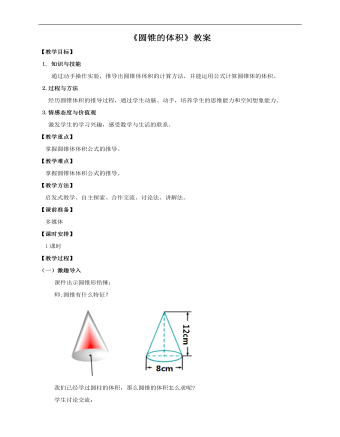
小学数学人教版六年级下册《第五课圆锥的体积》教案说课稿
(二)探究新知 1. 探究圆锥的体积的计算方法,学习例2。师:圆锥的体积和圆柱的体积有没有关系呢?圆柱的底面是圆,圆锥的底面也是圆……通过实验探究一下圆锥和圆柱体积之间的关系。小组合作探索:(1)各组准备好等底、等高的圆柱、圆锥形容器。(2)用倒沙子或水的方法试一试。(3)圆锥的体积与同它等底等 高的圆柱体积之间有什么关系?(4)小组活动,师巡视指导。2.推导圆锥体积的计算方法。 (1)课件演示等底等高的圆柱和圆锥
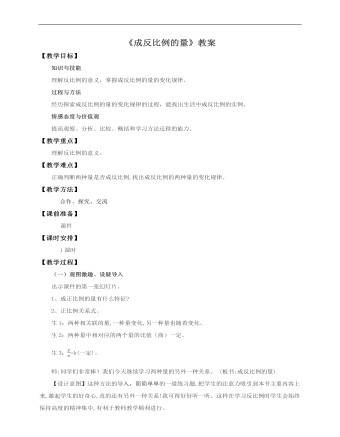
小学数学人教版六年级下册《第二课成反比例的量》教案说课稿
【教学过程】(一)观图激趣、设疑导入 出示课件的第一张幻灯片。1、成正比例的量有什么特征?2、正比例关系式。生1:两种相关联的量,一种量变化,另一种量也随着变化。生2:两种量中相对应的两个量的比值(商)一定。生3:=k(一定)。师:同学们非常棒!我们今天继续学习两种量的另外一种关系。 (板书:成反比例的量)【设计意图】这种方法的导入,简简单单的一道练习题,把学生的注意力吸引到本节主要内容上来,激起学生的好奇心,真的还有另外一种关系!我可得好好听一听。这样在学习反比例时学生会始终保持高度的精神集中,有利于教师教学顺利进行。(二)探究新知教学例2,探究反比例的意义,理解成反比例的量。1、出示PPT课件回答问题。杯子的底面积与水的高度的变化情况如下表。 杯子的底面积/cm²1015203060…水的高度/cm302015105…观察上表,回答下面的问题。(1)表中有哪两种量?(2)水的高度是怎样随着杯子底面积的大小变化而变化的?(3)相对应的杯子的底面积与水的高度的乘积分别是多少?生1:表中有杯子的底面积和水的高度这两种量。生2:从表中可以看出:水的高度随着杯子的底面积的变大而不断变小,这两种量是相关联的两种量。生3:我来回答(3),相对应的杯子的底面积与水的高度的乘积分别是:10×30=15×20=20×15=30×10=60×5=…=300。生4:乘积一定。师:底面积与高的乘积表示的是什么?生:水的体积。(板书)师:你会算出水的体积吗?生:会。(学生计算,教师出示课件订正)2、揭示反比例的意义。师:积是300,实际就是倒入杯子的水的体积。同学们能用式子表示出它们的关系吗?生:它们的关系是:底面积×高=体积。师:同学们,我们用概括正比例意义时的方法来概括一下反比例的意义吧!生:像这样,两种相关联的量,一种量变化,另一种量也随着变化,如果这两种量中相对应的两个数的乘积一定,这两种量就叫做成反比例的量,它们的关系叫做反比例关系。(板书反比例的意义)3、用字母表示反比例关系:xy=k(一定)。(板书)4、牛刀小试。锅炉房烧煤的天数与每天烧煤的吨数如下表: 每天烧煤的吨数/吨11.522.53烧煤的天数/天3020151210(1)表中有哪两种量?它们是不是相关联的量?(2)写出几组这两种量中相对应的两个数的积,并比较大小,说一说这个积表示什么。(3)烧煤的天数与每天烧煤的吨数成反比例吗?为什么?【参考答案】 (1)每天烧煤的吨数和烧煤的天数,是相关联的量。 (2)1×30=30 1.5×20=30 2×15=30 2.5×12=30 3×10=30 积相等,这个积表示这批煤的总吨数。 (3)成反比例,因为烧煤的天数与每天烧煤的吨数的积一定。【设计意图】学生通过观察、发现、概括经历了整个学习过程,逐步形成定向思维方式,为学会学习打好基础。
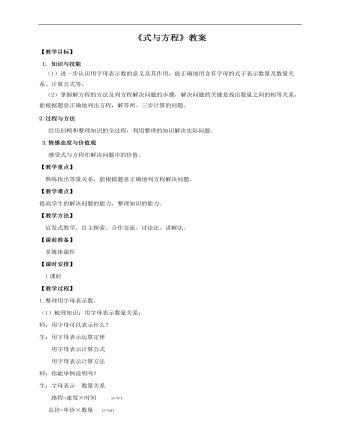
小学数学人教版六年级下册《第三课式与方程》教案说课稿
1.整理用字母表示数。(1)梳理知识:用字母表示数量关系:师:用字母可以表示什么?生:用字母表示运算定律用字母表示计算公式用字母表示计算方法师:你能举例说明吗?生:字母表示 数量关系路程=速度×时间 s=vt总价=单价×数量 c=an工作总量=工作效率×工作时间 c=at(2)字母表示计算方法:+=(3)用字母表示计算公式。师:用字母可以表示哪些平面图形的计算公式生:长方形 周长 c=(a+b) ×2 面积:s=ab 正方形 周长 c=4a 面积:s=a2 平行四边形 面积 s =ah三角形 面积 s=ah¸2 梯形 面积 s=(a+b)·h¸2 圆 周长c=πd=2πr 面积 s=πr2(4)用字母表示运算定律加法交换律 a+b=b+a 加法结合律 (a+b)+c=a+(b+c)乘法交换律 a×b=b×a乘法结合律 (a×b)×c=a×(b×c)乘法分配律 (a+b)×c=a×c+b×c2.在一个含有字母的式子里,数与字母、字母与字母相乘,书写时应注意的问题。师:在一个含有字母的式子里,数与字母、字母与字母相乘,书写时应注意什么?生交流:(1)在含有字母的式子里,数和字母中间的乘号可以用“?”代替,也可以省略不写。(2)省略乘号时,应当把数写在字母的前面。(3)数与数之间的乘号不能省略。加号、减号、除号都不能省略。3. 典题训练(1)填一填。①李奶奶家本月用电a千瓦时,比上个月多用10千瓦时,上个月用电( )千瓦时。②如果每千瓦时电的价格是c元,李奶奶家本月的电费是( )元。李奶奶家银行缴费卡上原有215元,扣除本月电费后,还剩( )元。③小明今年m 岁,妈妈的岁数比她的3倍少6岁。妈妈的岁数是( )岁。如果m=12,妈妈今年是( )岁。④三个连续的自然数,最大的一个是n,那么最小的一个数是( )。(2)连 一 连。比a多3的数 a3比a少3的数 3a3个a相加的和 a+33个a相乘的积 a-3a的3倍 a的
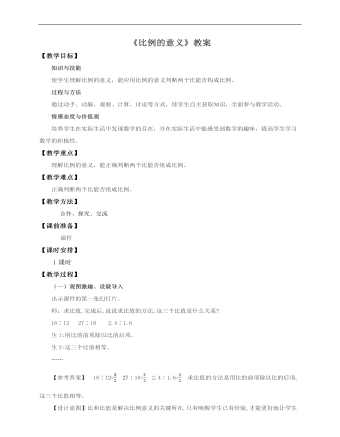
小学数学人教版六年级下册《第一课比例的意义》教案说课稿
(一)观图激趣、设疑导入 出示课件的第一张幻灯片。师:求比值,完成后,说说求比值的方法,这三个比值是什么关系?18∶12 27∶18 2.4∶1.6生1:用比的前项除以比的后项。生2:这三个比值相等。……【参考答案】 18∶12= 27∶18= 2.4∶1.6= 求比值的方法是用比的前项除以比的后项,这三个比值相等。【设计意图】比和比值是解决比例意义的关键所在,只有唤醒学生已有经验,才能更好地让学生投入到学习比例意义活动中来,为实现教学目标做好铺垫。(二)探究新知师:同学们,每周一的早上我们学校都要举行庄严的升国旗仪式,那么,你们对国旗都有哪些了解呢? 生1:我们的国旗是红色的,上面有五颗黄色的五角星。生2:我们的国旗是长方形的。师:同学们回答得真好,说出了自己对国旗的了解,可以看出同学们对我们国家的热爱,老师希望你们一定要好好学习,为我们的五星红旗增光!五星红旗是庄严而美丽的, 并且它与我们数学也有着密切的联系,这也就是我们今天所要研究的内容——比例。(板书课题:比例的意义)国旗长5米,宽米。国旗长2.4米,宽1.6米。国旗长60厘米,宽40厘米。
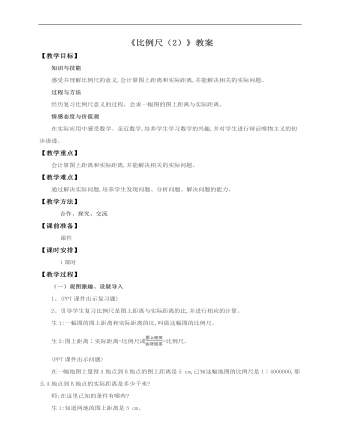
小学数学人教版六年级下册《第一课比例尺(2)》教案说课稿
(一)观图激趣、设疑导入 1、(PPT课件出示复习题)2、引导学生复习比例尺是图上距离与实际距离的比,并进行相应的计算。生1:一幅图的图上距离和实际距离的比,叫做这幅图的比例尺。生2:图上距离∶实际距离=比例尺或=比例尺。(PPT课件出示问题)在一幅地图上量得A地点到B地点的图上距离是5 cm,已知这幅地图的比例尺是1∶4000000,那么A地点到B地点的实际距离是多少千米?师:在这里已知的条件有哪些?生1:知道两地的图上距离是5 cm。生2:知道比例尺是1∶4000000。师:要解决的问题是什么?生:计算两地的实际距离是多少千米。师:这节课我们就接着来学习比例尺的应用,学习如何利用比例尺来解决实际问题,也就是已知比例尺和图上距离,求实际距离。(板书课题)【设计意图】通过把复习题中的习题变换已知和未知条件来变成本节课要解决的问题,使学生产生浓厚的兴趣,并且,也有助于培养学生举一反三、触类旁通的能力,使学生认识到数学知识的灵活性。(二)探究新知探究学习例2,已知比例尺和图上距离,求实际距离。1、PPT课件出示P54例3。下面是北京轨道交通路线示意图。地铁1号线从苹果园站至四惠东站在图中的长度大约是7.8 cm,从苹果园站至四惠东站的实际长度大约是多少千米?2、引导学生分析探究:师:从例题中可以知道哪些已知条件?生:可以知道两站的图上距离大约是7.8cm。师:这是从题目中直接读出来的,那么从所给的图中还能观察到什么条件呢?生:可以知道比例尺是1∶400000。布置学生小组讨论怎么样解决问题。学生以小组为单位进行合作学习,教师进行指导。3、汇报学习成果,师生共同探究:师:你们是怎么解答的?生1:通过列方程来解答的。生2:根据题意,可以先设实际长度为x cm,再根据“图上距离∶实际距离=比例尺”,列方程解答。师:解答时要注意什么?生1:要求实际距离是多少千米,但已知的图上距离是多少厘米,可以先设实际距离为x cm,算出实际距离的厘米数后,再化成千米数。生2:根据“图上距离∶实际距离=比例尺”,可以用解比例的方法求出实际距离。4、完成解答:(板书解题过程)图上距离:实际距离=比例尺解:设从苹果园站到四惠东站的实际长度是x cm。=x=7.8×400000x=31200003120000 cm=31.2 km答:从苹果园站到四惠东站的实际长度大约是31.2 km。5、拓展延伸:师:我们除了用方程解答之外,还可以用什么方法解答?生:可以用算术方法解答。师:可以怎样来分析呢?生:在“图上距离∶实际距离=比例尺”中,实际距离既可看成分数的分母,又可看成除法中的除数,所以可得出实际距离=图上距离÷比例尺。师:我们来共同完成解答:(板书过程)图上距离:比例尺=实际距离7.8÷=3120000(cm)3120000 cm=31.2 km答:从苹果园站到四惠东站的实际长度大约是31.2 km。6、牛刀小试。(1)师:我们一起来做两个练习题,看我们对新知识的掌握程度如何。(PPT课件出示)①教材P54做一做。先把教材P54做一做的图中的线段比例尺改写成数值比例尺,再用直尺量出图中河西村与汽车站之间的距离是多少厘米,并计算出两地的实际距离大约是多少。
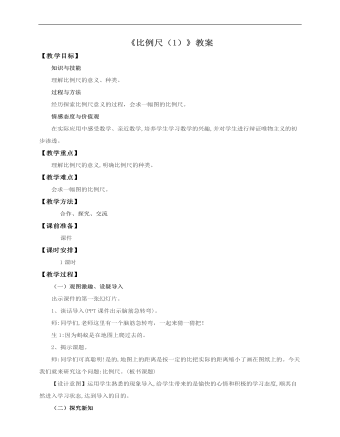
小学数学人教版六年级下册《第一课比例尺(1)》教案说课稿
(一)观图激趣、设疑导入 出示课件的第一张幻灯片。1、谈话导入(PPT课件出示脑筋急转弯)。师:同学们,老师这里有一个脑筋急转弯,一起来猜一猜把!生1:因为蚂蚁是在地图上爬过去的。2、揭示课题。师:同学们可真聪明!是的,地图上的距离是按一定的比把实际的距离缩小了画在图纸上的。今天我们就来研究这个问题:比例尺。(板书课题)【设计意图】运用学生熟悉的现象导入,给学生带来的是愉快的心情和积极的学习态度,顺其自然进入学习状态,达到导入的目的。(二)探究新知教学比例尺的意义及种类,理解比例尺的含义以及关系式。1、阅读教材第53页关于比例尺的内容。师:阅读教材后,汇报你知道了哪些关于比例尺的知识。生1:通过阅读我知道:一幅图的图上距离和实际距离的比,叫做这幅图的比例尺。图上距离∶实际距离=比例尺。(板书比例尺的意义)=比例尺生2:比例尺是绘图时用的,它是把实际距离按一定的比缩小或扩大,再画在图纸上。生3:教材介绍说,地图上的比例尺有1∶100000000,这是数值比例尺,它也可以写成这种形式,也叫数值比例尺。(板书)生4:老师,我看见这样表示比例尺的: 师:这叫线段比例尺。 它表示的是:图上1厘米的距离相当于地面上50 km的实际距离。(板书)生5:我会把上面的线段比例尺改成数值比例尺。图上距离∶实际距离。=1 cm∶50 km=1 cm∶5000000 cm(单位要相同)=1∶5000000(板书过程)生6:比例尺1∶5000000表示图上距离是实际距离的。实际距离是图上距离的5000000倍。
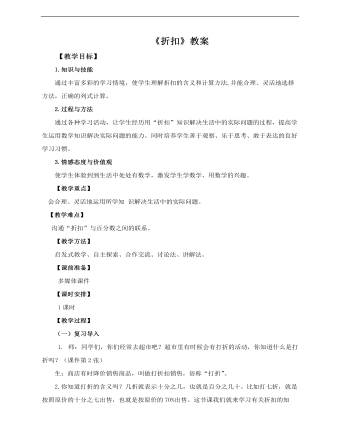
小学数学人教版六年级下册《第一课折扣》教案说课稿
(一)复习导入 1. 师:同学们,你们经常去超市吧?超市里有时候会有打折的活动,你知道什么是打折吗?(课件第2张)生:商店有时降价销售商品,叫做打折扣销售,俗称“打折”。2.你知道打折的含义吗?几折就表示十分之几,也就是百分之几十。比如打七折,就是按照原价的十分之七出售,也就是按原价的70%出售。这节课我们就来学习有关折扣的知识。(课件第3张)【设计意图】联系学生的生活实际引入课题,引起学生学习兴趣,使学生体会到生活中处处有数学。(二)探究新知 1、探究折扣的含义,计算打折后的价钱。(课件第3张)(1)星期天,小雨和爸爸来到商场买东西,正好赶上打折活动。小雨问爸爸:什么叫做“八五折”?你能回答小雨的问题吗?生1:“八五折”就是按原价的85%出售。你知道“九折”是多少吗?生2:“九折”就是按原价的90%出售。(2)爸爸给小雨买了一辆自行车,原价180元,现在商店打八五折出售。买这辆车用了多少钱?你会列式吗?(课件第4张)小组合作:你是怎样想的?说说你的思考过程。(课件第5张)(3)汇报交流:生1:把原价看做单位“1”,打八五折就是按原价的85%出售。(课件第6张)生2:现价=原价×折扣,求现价,做乘法。生3:180×85%=153(元)答:买这辆车用了153元。2、探究计算打折后便宜了多少钱的方法。爸爸买了一个随身听,原价160元,现在只花了九折的钱,比原价便宜了多少元?(课件第7张)(1)小组讨论:先求什么?再求什么?说说你的思考过程。生1:我先求现价是多少,再求比原价便宜了多少元。(课件第8张)列式为:160×90%=144(元)160-144=16(元)答:比原价便宜了16元。生2:我先求现价比原价便宜了百分之几,再求比原价便宜了多少元。(课件第9张)列式为:160×(1-90%)=160×10%=16(元)
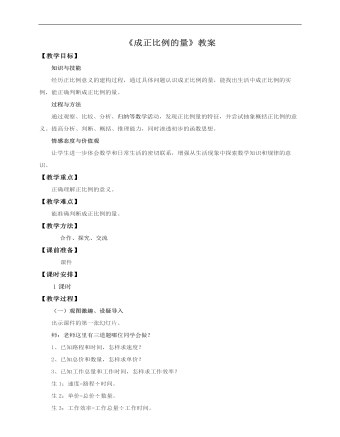
小学数学人教版六年级下册《第一课成正比例的量》教案说课稿
(一)观图激趣、设疑导入 出示课件的第一张幻灯片。师:老师这里有三道题哪位同学会做?1、已知路程和时间,怎样求速度?2、已知总价和数量,怎样求单价?3、已知工作总量和工作时间,怎样求工作效率?生1:速度=路程÷时间。生2:单价=总价÷数量。生3:工作效率=工作总量÷工作时间。师:同学们可真棒!这节课我们就来研究这些数量间的一些规律和特征。你们准备好了吗?生:准备好了!(板书:成正比例的量)【设计意图】引发学生学习的兴趣,唤起学生已有的只是经验,更好地进行新旧知识的结合,也有利于引导学生发现数量关系内在的规律。(二)探究新知(PPT课件出示例1)文具店有一种铅笔,销售的数量与总价的关系如下表。 数量/支12345678…总价/元3.5710.51417.52124.528…观察上表,回答下面的问题。(1)表中有哪两种量?(2)总价是怎样随着数量的变化而变化的?(3)相应的总价与数量的比分别是多少?比值是多少?1.探究数量与总价两个量之间的关系。师:仔细观察这张表格,它为我们提供了哪些数学信息?生:给我们提供了文具店销售彩带的数量是1,2,3,4,5,6,7,8米,总价分别是:3.5, 7,10.5,14,17.5,21,24.5,28元。师:表中有哪两种量?生:有数量和总价两种量。师:总价是怎样随着数量的变化而变化的?生:总价是随数量的增加而增加的。师:相应的总价与数量的比分别是多少?比值是多少?生1:=3.5 =3.5 =3.5 =3.5 =3.5 =3.5 =3.5 =3.5生2:相对应的总价和数量的比的比值是一定的。师:总价与数量的比值表示什么?
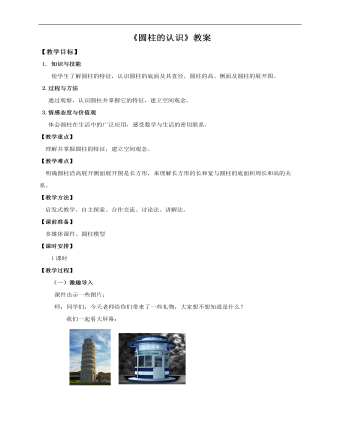
小学数学人教版六年级下册《第一课圆柱的认识》教案说课稿
(一)激趣导入 课件出示一些图片:师:同学们,今天老师给你们带来了一些礼物,大家想不想知道是什么?我们一起看大屏幕:你们认识这些物体吗?在生活中见到过吗?生:比萨斜塔、治安岗亭、茶叶盒、客家围屋。师:今天这节课我们重点来研究这些物体。(二)探究新知 1. 认识圆柱。师:这些物体什么形状的?它们的形状有什么共同特点?生:这些物体都是圆柱形的。师小结:这些物体的形状都是圆柱体,简称圆柱。说一说生活中有哪些圆柱形的物体。2.探究圆柱的特特征。(1)认识底面小组活动: 观察圆柱形物体,看看它是有几部分组成的,有什么特征?课件演示:圆柱的上、下两个面叫做底面,是两个完全相同的圆。 师:请同学们量一量、算一算圆柱的两个底面有什么关系?生1:两个底面的直径相等、半径相等。生2:两个底面的周长相等、面积相等。师小结:圆柱的底面是两个完全相同的圆。(2)认识侧面课件演示:圆柱周围的面叫做侧面,侧面是一个曲面。师:请同学们指一指圆柱的侧面,再用手摸一摸,有什么感觉?生:侧面是弯曲的。师:侧面是一个曲面。
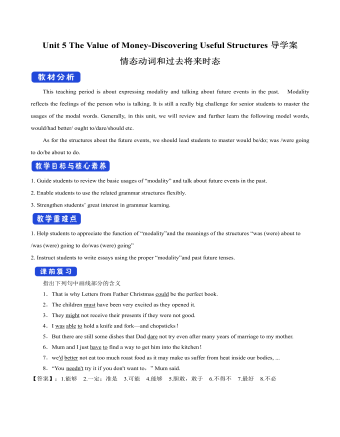
新人教版高中英语必修3Unit 5 The Value of Money-Discovering Useful Structures导学案
4.They were going to find someone to take part in their bet when they saw Henry walking on the street outside.[归纳]1.过去将来时的基本构成和用法过去将来时由“would+动词原形”构成,主要表示从过去某一时间来看将要发生的动作(尤其用于宾语从句中),还可以表示过去的动作习惯或倾向。Jeff knew he would be tired the next day.He promised that he would not open the letter until 2 o'clock.She said that she wouldn't do that again.2.表示过去将来时的其他表达法(1)was/were going to+动词原形:该结构有两个主要用法,一是表示过去的打算,二是表示在过去看来有迹象表明将要发生某事。I thought it was going to rain.(2)was/were to+动词原形:主要表示过去按计划或安排要做的事情。She said she was to get married next month.(3)was/were about to+动词原形:表示在过去看来即将要发生的动作,由于本身已含有“即将”的意味,所以不再与表示具体的将来时间状语连用。I was about to go to bed when the phone rang.(4)was/were+现在分词:表示在过去看来即将发生的动作,通常可用于该结构中的动词是come,go,leave,arrive,begin,start,stop,close,open,die,join,borrow,buy等瞬间动词。Jack said he was leaving tomorrow.

人教版高中英语必修1Journey Down the Mekong说课稿
2. let the Ss complete the forms paragraph by paragraph. Purpose here is to help Ss to get the habit of reading a passage as a whole, and pay attention to the organization of the text, as a result the Ss will fully understand the whole passage.3. ask Ss to retell the passage with the help of the key words in the form.Since the Ss in the class are in different levels, so I let them to fill in the blank to understand the meaning of the words and phrases better. ( That’s all for the while-reading. Now let’s move to the fifth step.)Step V: Post-reading (10mins) ---DiscussionIn this part students are asked to discuss in groups and list Wang Kun’s and Wang Wei’s attitudes about the trip. After that, Ss are encouraged to express their attitudes with the whole class. Collect their answers and don’t forget to praise them even if their answers may not be perfect.In this activity, discussion provides a vivid and active learning environment for Ss to communicate in English with newly learned language items. (Finally it comes to the homework.)StepⅥ: Homework (1min)1. Ss are required to read the text again after class and figure out the meaning of some complex sentences.2. Do the exercises on P19; This can help Ss to consolidate what they’ve learnt and make preparation for the next lessonPart4. Blackboard design.(说板书设计)On the top, there is the title of this lesson. On the left, there are main ideas for each paragraph. On the right, there are some new words and expressions.Unit 3 Travel journalJourney down the MekongMain idea of each para.:Para1: deciding to take a great bike trip along the Mekong river.Para2: Different attitudes between Wang kun and Wang wei.

人教版高中英语必修4Body Language说课稿4篇
Textbook: Senior English for China (Book 4), by Liu Daoyi Time Allotment: 1 period (40 minutes)Date: March 20, 2014Teaching aids: blackboard, Multi-media, Power Point, chalk I. Text Analysis (教材分析)This unit is about body language, and the text selected in the reading part demonstrates the difference and similarity of body language in many parts of the world. Through learning this passage, students are required to raise their awareness of using body language in different parts of the world. As body language is closely related to our daily life, it is easy to arouse students’ interest in learning this text. Reading skills and speaking training are designed around the text.II. Teaching Objectives (教学目标)By the end of the lesson, students will be able to:1. Language Skill Objective(语言技能目标): develop reading ability (skimming and scanning)as well as speaking ability.2. Cultural Knowledge Objective(文化知识目标): know about the cultural differences of using body language.3. Affective Objective(情感目标): increase students’ awareness of using body language correctly in different cultures. III.Teaching Focuses and Difficulties(教学重点和难点)1. Teaching Focuses(教学重点): the difference and similarity of body language in many parts of the world.2. Teaching Difficulties(教学难点): develop students’ reading abilities of skimming and scanning and ask the students to show their opinions with fluent English.

人教版高中英语必修1Anne's best friend说课稿
Step 7 Language points 1.Vocabulary (1) go through (2) set down (3) a series of (4) on purpose (5) in order to (6)at dusk (7)entirely (8)face to face 2.Important sentences (1)…I’ve grown so crazy about everything to do with nature. (2)There was a time when … (3)I stayed awake on purpose until … (4)It was the first time … that I’d seen the night … (5)It’s no pleasure looking through … Purpose: 1.Master the required vocabulary and sentence structures. 2.Use them freely. Step 8 Consolidation 1.Find out the topic sentences 2.Retell the text according to the topic sentences Purpose: I want to know if my students understand the text. Step 9 Discussion Imagine you have to go into hiding like Anne and her family, what would you miss most? Giveyour reasons. Purpose: Train Ss’ oral English ability. Step 10 Homework Write an article on Friends. Purpose: 1. Improve the Ss’ writing ability. 2 Train the Ss’ ability of self—teaching and looking up information by themselves. Part 5 Blackboard design(说板书设计)Unit 1 Friendship Reading Anne’s Best Friend 1.Main idea of each paragraph: Para. 1 Anne made her diary her best friend. Para .2 Anne wrote her feelings in her diary. Para .3 Anne missed nature. Para.4 Anne saw the night face to face Para.5 Anne wanted to experience nature outdoors. 2.Listening: Exx.1 P3 3.Discussion: Exx.3 P3 Purpose: 1.Make Ss familiar with the passage 2.Make the design inductive, instructive and artistic.

人教版高中英语必修1English around the world说课稿
(3)v. 给:提出;展现,显现present sb. with sth. ; present sth. to sb. 把. . 交给;颁发;授予present sth. (for sth. )/present sth. to sb. e. g. Om his birthday, his friends presented him a collection of stamps. 在他生日时,他的朋友们送给他一套邮票作为礼物。The sword was presented by the family to the museum. 这家人把宝剑捐赠给了博物馆。The committee will present the final report to Parliament in June. 委员会将在六月向议会提交最后的报告。You need to present yourself better. 你需要更善于展现自己。It is essential that we present a united front. 至关重要的是我们要表现得更加团结。Step 4 ConsolidationT:Now that we have got a general idea of these words and phrases. Lets make up some sentences using them to master them. Suggested sentences:1. Your duties include typing letters and answering the telephone. 2. It is one of the greatest roles that she has played. 3. A large number of people have applied for the job. 4. The number of the panda is declining. 5. I'11 go there, even if I have to walk. 6. He came up to me to ask for a light. 7. The novel is about a family who can't communicate with each other. 8. He based his plan on interests of most people. 9. Why doesn't he make use of his singing talent?Step 5 Summary and homeworkT:Today we dealt with several new words and phrases. After class I hope that youcan read them again and again to keep them in mind. That's all for today. You aredismissed.

人教版高中英语必修1Nelson Mandela--A Modern Hero说课稿
In this step, give students a few minutes to read the passage . While they are reading, I will write some key words of the text on the blackboard. Then ask students to retell the passage according to the key words.By retelling, students can improve their ability of language organization and have an overall understanding of the article.Step 4 Group discussionIn this step, students will be divided into groups of 4 to discussion the following question: What qualities make a great person?After their discussion, invite a few groups to make a report to the class.This group discussion can practice students’ oral English and cultivate their abilities of cooperation and communication.Step 5. HomeworkLet students write a short passage to introduce a great person he or she admires.The homework can consolidate the knowledge the students have learned and cultivate their writing ability. Part 6 Blackboard Design(板书设计)That’s all my teaching procedures. Finally, I’d like to say sth about part 6 blackboard design. On the top is the title. On the left, there will be some new words and expressions. In the middle of the blackboard, I will write some useful sentence structures so that the students can know clearly what they’ve learned and then try to master the knowledge.OK. That’s all for my presentation. Thank you for your attention.

人教版高中英语必修2Computers说课稿3篇
一. 教材分析1. 本单元的中心话题是“计算机(Computers)”,内容涉及计算机的发展历史,计算机的应用等。本节课是该单元的第一课时,我将Warming up, Pre-reading and Comprehending这四部分整合为一节精读课。其中。Reading部分是题为WHO AM I?的文章,以第一人称的拟人手法介绍了计算机发长演变的历史和计算机在各个领域的应用,其主旨是表达计算机的发展变化之快以及在生活中用途之广。而Warming up部分以图片的形式展现了计算机的发展历程;Pre-reading中的问题和排序分别是为了预测语篇的内容和测试学生对计算机历史了解的情况;Comprehending则通过各项练习训练学生的阅读技能,从而加深对文章的理解。可见这几部分是一个有机的整体。2. 教学目标:1) 语言目标:重点词汇及短语:abacus, calculate, calculator, PC, laptop, PDA, robot, analytical, technological, universal, mathematical, artificial, intelligent, network, explore, in common, as a result.重点句子:a. My real father was Alan Turing, who in 1963 wrote a book to describe how computers could be made to work, and build a “universal machine” to solve any mathematical problem.

人教版高中英语必修2Cultural Relics说课稿2篇
Ⅲ. Analysis of the teaching material:The topic of this unit is cultural relics. Students are quite interested in topics about different cultures around the world. This is the second period of the whole unit. As a reading class, the passage mainly talks about the history of the amber room (how it was made, sent as a gift, lost and rebuilt).According to the new national curriculum, when teaching reading, much emphasis should be put on training the students’ reading skills.Ⅳ. Teaching objectives1. Language objectives:1) Students are required to master the key words and phrases occurred in the passage (e.g. amazing, decorate, belong, in return, less than etc.)2) Students are required to learn the attributive clause and acquire the sentence pattern.2. 1) Students are required to describe a certain thing by using the new sentence patterns.2) Students are required to master two kinds of reading skills—skimming and scanning, and learn to use them in their daily reading.3. 1) Students are required to know the history of the amber room.2) Students are required to appreciate cultural relics and understand the importance of protecting them.Ⅴ. Teaching important and difficult points1) the new words, phrases, and sentence pattern in the course of reading.2) Teaching difficult point: Help the students master two kinds of reading skills—skimmingand scanning and learn to apply them in daily use.Ⅵ. Teaching methods:Task-based method & Top-down model Ⅶ. Teaching aids: PPT, pictures, blackboard Ⅷ. Teaching procedure:

人教版高中英语必修2The Olympic Games说课稿2篇
Purpose of my design:To ask the students to do these two tasks will make the Ss predict the story of this passage. As a result, it will deepen Ss’ memory of this story because they will have their own understanding of this story.Step 3. While-readingTask 1. (Individual work _____min)Skimming: ask students to skim the text and the main ideas of each paragraph in this passage. Please read it quickly and then match the sentences with the letters.Task 2. (Individual work _____min)Scanning: read the text quickly and decide the whether the following statements are true or false and give reasons.Task 3. (Pair work _____min)Listen to the tape and fill in the banks. Then read the paragraph with expression to your partner.Task4 (individual work min)Listen to the tape again and write down the main idea in one sentence.Purpose of my design: Enable students to understand the given material better by using different reading skills. And proper competition can arouse the Ss’ interest in English learning. “Task-based” teaching method is used here todevelop the Ss’ ability of communication and also their ability of co-operation will be well trainedStep 4. Post-readingTask 1. (Individual work, pair work, group work, class work; _____min)Discussion (group of 4):1. If you were Hippomenes, would you run against Atlanta?2. Do you think Hippomenes deserved to win the race? Why or why not?Step 5. HomeworkPlease read the story again carefully after class and imagine: What will happen during the race between Hippomenes and Atlanta? Who do you think will win the race? Do you think Atlanta would marry Hippomenes? Write an end for the story with thses questions.Purpose of my design: Homework is so important and necessary for to master the knowledge they learned after class. It will check whether the Ss achieve the teaching aims.Part 5 Blackboard design

人教版高中英语必修3Astronomy the science of the stars说课稿3篇
Step 2 Pre-listeningAfter students finish their discussion, I will show a picture of Newton and ask them: Who is him? What is he famous for? Could you find out some words to describe him? Maybe students will answer that he is genius for his finding of theGravitation, making a great contribution to the progress of human being. At that time I will show another two pictures of Einstein and Hawking, letting students guess who they are and write down their idea about the Gravitation. For I have arranged them to search more information about the gravity before this class, Students have beenfamiliar with the topic and will not be afraid about this abstract conception, which is helpful for their listening.Step 3 While-listeningIn this step, students will be required to listen the material for three times. The first and listening is extensive listening and the second and third listening is intensive listening. In the first time, They are required to listen a material including Part 1 and Part 2 and choose the best summary of the listening text. After they choose the right answer, They also need work in group to explain what is wrong with the others. Then I will make a conclusion that we should pay attention to the first paragraph and last paragraph and some keys to get the main idea. By doing this, their capacity of generalization will have a great improvement.Before the second listening, I will ask students to scan the blank on the power point quickly and ask them to note down some key words .Then ask them to listen to the Part 1again and fill the first column of the chart. Maybe some students just show the ideas of these three scientists an still can’t catch their development of gravity. Therefore, I will ask them to listen to Part 2 again and fill in the rest. After finish the listening, I will give them ten minutes to discuss with their partner. I will also guidethem to improve their answers when they discuss with others.

人教版高中英语必修2Wildlife Protection说课稿3篇
When it comes to the students’ studying methods, I'd like to introduce my Ss first. The Ss have a good command of basic language points. They’re interested in learning English, and they take an active part in English class, so they will have fun in autonomous, cooperative and inquiry learning. I will just serve as a guide, showing them the way to explore how to make more progress in their English learning.Now it’s time for the most important stage of this lesson. My teaching procedures are arranged as follows:Step1.Leading-in (3 minute)Play a video of a wide variety of wildlife to introduce my topic. Step2. Speaking (12 minutes)We will use our textbook Page25. Let the Ss fast read the short paragraph to warm up. Ask them to talk about the report on some endangered wildlife in China with the dialogue patterns on the screen. Lastly, I will invite some groups to demonstrate their dialogues about saving wildlife in China.Step3.English play (3 minutes)Watch another video in praise of their excellent performance just now. It’s about Jack Chen’s(成龙)and Yang Ziqiong’s wildlife protection.Step4. Listening (twice 13 minutes)This time, I’ll ask the Ss to fill in the blanks of the monologue of the 2 movie stars above. Step5.Discussion (3 minutes)Which would you like to choose to wear, clothes made of cotton, artificial leather or animal skins? Why ?Step6. Summary (3 minutes)1. If there were no wildlife, there wouldn’t exist human beings. If the buying stops, the killing can, too.2. Animals are our friends. To love animals is to love ourselves. Stop hunting, killing and destroying wildlife.3. Let’s live in harmony with all the living things in the world. Step7. Music appreciation (3 minutes)Let the Ss appreciate the song Earth Song by Michael Jackson. Last but not the least, I will show you my blackboard design.

